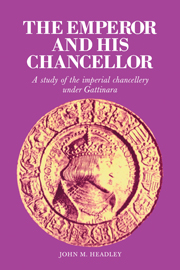Book contents
- Frontmatter
- Contents
- Acknowledgments
- List of abbreviations
- Introduction
- 1 The administrative threshold
- 2 The emerging government of Charles V
- 3 The conflict between chancellor and emperor
- 4 The imperial chancellery
- 5 The imperial propaganda campaign of 1526–1527
- 6 The last years of the chancellorship
- Epilogue
- Appendix 1 The Summary by Philippe Hanneton, audiencier of the Burgundian chancellery, regarding the office of the Grand Chancellor
- Appendix II ‘The Doubts of [Alonso de] Soria’, lieutenant protonotary, concerning Gattinara's proposals for reforming the Aragonese chancellery
- Appendix III Gattinara's ‘Brussels Remonstrance’
- Appendix IV Gattinara's proposals for the more effective operation of the Council of State
- Appendix V A comparative analysis of the movements of the imperial court and the imperial chancellery 1518–1530
- Bibliography
- Index
2 - The emerging government of Charles V
Published online by Cambridge University Press: 07 October 2011
- Frontmatter
- Contents
- Acknowledgments
- List of abbreviations
- Introduction
- 1 The administrative threshold
- 2 The emerging government of Charles V
- 3 The conflict between chancellor and emperor
- 4 The imperial chancellery
- 5 The imperial propaganda campaign of 1526–1527
- 6 The last years of the chancellorship
- Epilogue
- Appendix 1 The Summary by Philippe Hanneton, audiencier of the Burgundian chancellery, regarding the office of the Grand Chancellor
- Appendix II ‘The Doubts of [Alonso de] Soria’, lieutenant protonotary, concerning Gattinara's proposals for reforming the Aragonese chancellery
- Appendix III Gattinara's ‘Brussels Remonstrance’
- Appendix IV Gattinara's proposals for the more effective operation of the Council of State
- Appendix V A comparative analysis of the movements of the imperial court and the imperial chancellery 1518–1530
- Bibliography
- Index
Summary
On 15 October 1518, Mercurino Arborio de Gattinara knelt before Charles, King of Castile, shortly to become King of Aragon and emperor elect, and thereupon between the hands of the young Habsburg monarch took the oath of office as ‘Grand Chancellor of all the realms and kingdoms of the king’. In rising to his feet the new chancellor could hardly have surmised, beyond the obvious burdens and difficulties of trying to keep in harness so many diverse lands, the specific problems involved in trying to impose a Franco-Burgundian conception of the chancellorship upon a variety of realms each of whose chancelleries stood at a different stage of growth or decay. As former head of Margaret of Austria's privy council as well as President of Burgundy, i.e. the parlement at Dole, Gattinara had for the past ten years been thoroughly exposed to Franco-Burgundian administrative practices.2 Furthermore, as a self-conscious disciple of Justinian and a renowned Turin lawyer for ten years prior to his service with the Habsburg dynasty, Gattinara had developed a driving mastery of detail, an eye for the practical issues in a situation, a promptness of thought, a mind that sought to shape, order, improve. With these qualities and experience he would now attack his formidable responsibilities.
As is evident from an examination of the remnants of his private archive at Turin, Gattinara invited memoranda from subordinates at the beginning of his chancellorship as a means of informing himself about the needs, problems and resources of the lands and institutions under his master's lordship.
- Type
- Chapter
- Information
- The Emperor and His ChancellorA Study of the Imperial Chancellery under Gattinara, pp. 20 - 39Publisher: Cambridge University PressPrint publication year: 1983



